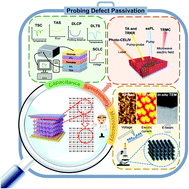Current state-of-the-art characterization methods for probing defect passivation towards efficient perovskite solar cells
Abstract
Various types of imperfections/defects in metal halide perovskite (MHP) light-absorbing layers and/or at relevant interfaces have indelible effects on perovskite solar cells (PSCs) in terms of performance, stability, and scalability. So far, some effective defect-passivation strategies and agents have successfully been applied to reduce defects in MHPs to improve film quality and device properties for future commercialized long-term stable large-scale PSCs. Characterization methods play an important role in clarifying the mechanistic understanding of defect passivation in MHPs, allowing the development of more efficient passivation strategies. Therefore, new advanced measurements of defect passivation, especially some in situ techniques that are different from conventional characterization tools, were reviewed in this paper aiming to provide useful guidelines for further continuously promoting MHP and PSC research.

- This article is part of the themed collection: Journal of Materials Chemistry A Emerging Investigators


 Please wait while we load your content...
Please wait while we load your content...